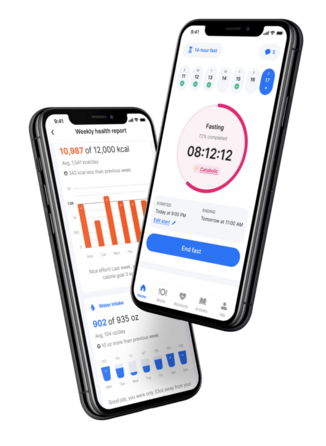Contents
How Much Weight Can You Expect To Lose Within a Month?
1-month weight loss expectations and results truly do differ, depending on person to person, but some scientific resources give you a good idea of the margins of exactly how much weight you could lose in about four weeks.
With that being said, your results will differ greatly with diet choice, exercise capacity, caloric intake, and many more aspects that can dramatically alter how much weight loss you experience.
So, how much weight can you lose in a week? In order to safely lose weight and keep it sustained further down the line, dropping around one to two pounds per week for healthy weight loss is acceptable, according to peer-reviewed studies by the Centers for Disease Control and Prevention.
And if you scale up this weight loss equation, that means four to eight pounds can be lost in one month, if you are dedicated and maintain a healthy lifestyle and healthy habits outside of losing weight!
Though it might not seem like much, losing 5% to 10% of your total body weight comes with a myriad of health benefits, including lower blood pressure, better cardiovascular health, and more energy. And for most people, that percentage can be only around 10 to 15 pounds when calculated.
The key here is to avoid yo-yo dieting that might ultimately lead to weight gain in the future, or even very-low-calorie diets that are unsustainable for long periods of time.
They don’t even need to be fad diets for your weight loss goals to stagnate— a traditional diet that requires you to limit yourself to only certain food groups or excessive exercise to lose more weight are often not sustainable weight loss methods.
One of the best options for safe weight loss results the healthy way is by intermittent fasting, which allows you to burn more fat stored in the body by pushing your metabolism into ketosis naturally, thanks to fasting periods and calorie counting.
Intermittent fasting is the best way to tackle your starting weight and progress towards your weight loss success safely and smoothly, along with a variety of associated benefits for both men’s and women’s health.
How Many Pounds Is It Safe To Lose?
To stay healthy and still reduce your current weight, it’s important to focus on sustainable weight loss instead of rapid methods for shedding one pound after another.
And when it comes to the question of how much weight can you lose in a month, while you might want to drop pounds quickly, you need to do so safely— sticking to the rate of one or two pounds per week is the healthy standard to aim for.
Overall, this can lead to a sustained weight loss of around 50 to 100 pounds per year, or losing between 5% and 10% of your body mass in the first six months.
And this should be done without starving your body while encouraging good exercise and eating habits— something that is easy if you decide to follow the route of intermittent fasting for the best weight loss success.
3 Things You Should Look Out for When Trying To Lose Weight
Most times, it’s better to consider how to change your lifestyle for the better, rather than asking how much weight can you lose in a week or going on a crash diet. This makes losing weight healthier, more enjoyable and prevents regaining pounds.
So, make sure to keep an eye out for the following 3 things during your weight loss journey, and avoid any diets that ascribe success to any of these practices.
-
Rapid Weight Loss
This is often touted as a dangerous practice, but what is considered rapid weight loss? If you are losing much more than two pounds a week, it is not sustainable or healthy in the long term.
The plans that promise such results are typically very low-calorie diets or other incredibly restrictive ones. Rapid weight loss is bad because it actually harms your body composition, metabolism, and your ability to burn more calories healthily.
-
Extremely Strict Diet
While portion control is important, you also should not be using meal plans that severely restrict your ability to eat all of your favorite foods. The key lies in balancing calories and hunger cues with how many pounds per week you want to lose.
And rigid menus are not a sustainable way to approach your weight loss, nor are they enjoyable! If you are constrained to specific food combinations and other limitations in order to burn calories, you will likely fall off the plan and gain weight all over again.
-
Not Exercising
Healthy weight loss per week does depend on integrating physical activity or strength training into your exercise plan.
If you are not exercising and relying on slashing your calories to lose weight instead, it’s not safe or sustainable. Instead, burn calories with regular workouts to smash your weight loss and keep yourself healthy.
Why Crash Diets Won’t Give Long-term Results?
Losing weight should be a long-term commitment and not an immediate goal. There is no safe way to lose ten pounds in two weeks or to maintain that weight. And that’s a reason why what is considered rapid weight loss diets don’t tend to work.
Instead, when facing massive calorie restrictions, your metabolism can actually slow down and you can lose muscle mass.
Healthy weight loss per week can be better achieved by eating fewer calories and increasing your body’s metabolism naturally, such as through intermittent fasting.
To seamlessly integrate weight loss into a healthy lifestyle, intermittent fasting can not only help with the pounds you lose in a month but also assist you in choosing better calories to fuel yourself outside of fasting periods, giving you more energy than ever before.
For any newcomers to the world of intermittent fasting, one of the best ways to get more information and get started is with the DoFasting app, which makes it easier than ever to count calories, improve your health, and help your weight loss progress.
Take a
1-minute quiz
and discover how much weight you can lose with DoFasting!

How To Lose Weight in 9 Easy Steps?
So, what are some steps to help increase the amount you lose in a month, while still enjoying the process and your daily life? Let’s go over 9 of the best ways to easily shed pounds without a weight loss surgery and be safe about it.
-
Set up S.M.A.R.T. Goals
Having S.M.A.R.T. goals are a great way to keep yourself accountable and stick to a weight loss plan, including the following aspects of the acronym:
- Specific— Set defined goals for yourself.
- Measurable— Track your progress.
- Attainable— Make realistic resolutions.
- Relevant— Tailor your goals to your lifestyle.
- Time-bound— Give yourself an end date.
S.M.A.R.T. helps you stay on the right track and maintain realistic goals for yourself, even when the going gets tough.
-
Adopt a Long-term Mindset
Don’t look at weight loss as a sudden change— it’s a much better long-term mindset that allows you to see the process as an entire lifestyle shift towards healthier habits. This view also allows you to lose weight slowly and steadily, while still feeling happy, instead of adopting yo-yo dieting.
-
Try Intermittent Fasting
Intermittent fasting is one of the best ways to reduce body weight by burning fat. If you want to become a happier and healthier you, then intermittent fasting might be the right path. And with several different time-determined eating and restricting windows, it’s easy to find the right intermittent fasting type for you with DoFasting.
-
Rethink Your Daily Habits
Making small changes goes a long way to losing weight, particularly when they are part of your routine. Avoid adding sugar to coffee or using high-calorie condiments, and skip beverages with empty calories like alcohol.
-
Eat Better Food, Not Less
Instead of restricting your calories to a bare minimum, make good choices about what you put into your system. Add more vegetables and protein to your meals, and make sure you’re getting enough fiber and vitamins every day instead of empty calories.
It’s all about eating better, not starving yourself!
For example, instead of reaching for a high-calorie snack, opt for a piece of fruit. Similarly, you can switch processed foods out for whole grains; a protein shake for fast food; and green tea for sugary beverages.
-
Practise Mindful Eating
Instead of eating rapidly, take the time to enjoy the experience. Eat slowly, be present at the moment, and chew each bite fully while savoring the flavors and texture of the food.
You should also sip water throughout eating to help hydrate your digestive system and feel fuller faster. Additionally, put your phone away and switch off the TV during mealtimes to fully connect with your body’s fullness signals.
-
Get Support
Humans are social creatures, and it’s no different during weight loss. Instead of going it alone, find a support group that includes others who are going through the same process and can relate to your struggles.
For example, Facebook commonly has weight loss support groups that provide the emotional assistance you might need, without having to commute into a physical location. Don’t be afraid to tap into a collective support network to get encouragement and avoid giving up on your journey!
-
Make Time for Regular Exercise
It’s important to exercise regularly when dieting. This will help build more muscle mass, reach fitness goals, and help keep your metabolism ready to burn fat and calories at maximum efficiency.
Plus, exercise has proven advantages for mental health and overall emotional wellbeing, so it’s a win-win.
-
Increase Your Daily Water Intake
Many people can mistake thirst for hunger, so you might find that increasing the amount of water you drink every day will not only help with staying hydrated but also feeling full. Drinking water is also great for the appearance of your skin and mental clarity!
Take a
1-minute quiz
and discover how much weight you can lose with DoFasting!

Conclusion
For succeeding in your 1-month weight loss, there are several aspects of dieting to keep in mind, including avoiding crash diets that promise rapid (and dangerous) weight loss.
Instead of trying to lose an unsustainable and unhealthy amount of weight quickly, opt for safe methods like intermittent fasting to achieve your weight and wellbeing goals.
By losing one or two pounds a week, you can have success with losing weight and not feel miserable in the process.
This is particularly true if you follow some great suggestions like thinking long-term, changing the way you look at food, and exercising regularly, all of which are possible with intermittent fasting!
See how DoFasting will improve your life
Find out what works for you with this 60-sec quiz approved by our experts and get your personal revolutionary fasting assistant.
Start the Quiz
This is an evidence-based article that includes scientific citations. DoFasting’s professional writers and editors prepared the content, which a team of medical experts verified to be accurate.














